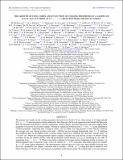THE GROWTH OF COOL CORES AND EVOLUTION OF COOLING PROPERTIES IN A SAMPLE OF 83 GALAXY CLUSTERS AT 0.3 <
Author(s)
McDonald, Michael A.; Bautz, Marshall W.
DownloadMcDonald-2013-THE GROWTH OF COOL C.pdf (6.842Mb)
PUBLISHER_POLICY
Publisher Policy
Article is made available in accordance with the publisher's policy and may be subject to US copyright law. Please refer to the publisher's site for terms of use.
Terms of use
Metadata
Show full item recordAbstract
We present first results on the cooling properties derived from Chandra X-ray observations of 83 high-redshift (0.3 < z < 1.2) massive galaxy clusters selected by their Sunyaev-Zel'dovich signature in the South Pole Telescope data. We measure each cluster's central cooling time, central entropy, and mass deposition rate, and compare these properties to those for local cluster samples. We find no significant evolution from z ~ 0 to z ~ 1 in the distribution of these properties, suggesting that cooling in cluster cores is stable over long periods of time. We also find that the average cool core entropy profile in the inner ~100 kpc has not changed dramatically since z ~ 1, implying that feedback must be providing nearly constant energy injection to maintain the observed "entropy floor" at ~10 keV cm[superscript 2]. While the cooling properties appear roughly constant over long periods of time, we observe strong evolution in the gas density profile, with the normalized central density (ρ g, 0/ρcrit) increasing by an order of magnitude from z ~ 1 to z ~ 0. When using metrics defined by the inner surface brightness profile of clusters, we find an apparent lack of classical, cuspy, cool-core clusters at z > 0.75, consistent with earlier reports for clusters at z > 0.5 using similar definitions. Our measurements indicate that cool cores have been steadily growing over the 8 Gyr spanned by our sample, consistent with a constant, ~150 M ☉ yr[superscript –1] cooling flow that is unable to cool below entropies of 10 keV cm2 and, instead, accumulates in the cluster center. We estimate that cool cores began to assemble in these massive systems at Z[subscript cool] = 1.0[+1.0 over -0.2], which represents the first constraints on the onset of cooling in galaxy cluster cores. At high redshift (z gsim 0.75), galaxy clusters may be classified as "cooling flows" (low central entropy, cooling time) but not "cool cores" (cuspy surface brightness profile), meaning that care must be taken when classifying these high-z systems. We investigate several potential biases that could conspire to mimic this cool core evolution and are unable to find a bias that has a similar redshift dependence and a substantial amplitude.
Date issued
2013-09Department
MIT Kavli Institute for Astrophysics and Space ResearchJournal
Astrophysical Journal
Publisher
Institute of Physics/American Astronomical Society
Citation
McDonald, M., B. A. Benson, A. Vikhlinin, B. Stalder, L. E. Bleem, T. de Haan, H. W. Lin, et al. “ THE GROWTH OF COOL CORES AND EVOLUTION OF COOLING PROPERTIES IN A SAMPLE OF 83 GALAXY CLUSTERS AT 0.3 < z < 1.2 SELECTED FROM THE SPT-SZ SURVEY .” The Astrophysical Journal 774, no. 1 (August 12, 2013): 23. © 2013 American Astronomical Society.
Version: Final published version
ISSN
0004-637X
1538-4357